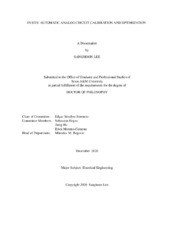| dc.description.abstract | As semiconductor technology scales down, the variations of active/passive device characteristics after fabrication are getting more and more significant. As a result, many circuits need more accuracy margin to meet minimum accuracy specifications over huge process-voltage-temperature (PVT) variations. Although, overdesigning a circuit is sometimes not a feasible option because of excessive accuracy margin that requires high power consumption and large area. Consequently, calibration/tuning circuits that can automatically detect and compensate the variations have been researched for analog circuits to make better trade-offs among accuracy, power consumption, and area.
The first part of this dissertation shows that a newly proposed in situ calibration circuit for a current reference can relax the sharp trade-off between the temperature coefficient accuracy and the power consumption of the current reference. Prototype chips fabricated in a 180 nm CMOS technology generate 1 nA and achieve an average temperature coefficient of 289 ppm/°C and an average line sensitivity of 1.4 %/V with no help from a multiple-temperature trimming. Compared with other state-of-the-art current references that do not need a multiple-temperature trimming, the proposed circuit consumes at least 74% less power, while maintaining similar or higher accuracy.
The second part of this dissertation proves that a newly proposed multidimensional in situ analog circuit optimization platform can optimize a Tow-Thomas bandpass biquad. Unlike conventional calibration/tuning approaches, which only handle one or two frequency-domain characteristics, the proposed platform optimizes the power consumption, frequency-, and time-domain characteristics of the biquad to make a better trade-off between the accuracy and the power consumption of the biquad. Simulation results show that this platform reduces the gain-bandwidth product of op-amps in the biquad by 80% while reducing the standard deviations of frequency- and time-domain characteristics by 82%. Measurement results of a prototype chip fabricated in a 180 nm CMOS technology also show that this platform can save maximum 71% of the power consumption of the biquad while the biquad maintains its frequency-domain characteristics: Q, ωO and the gain at ωO. | en |


